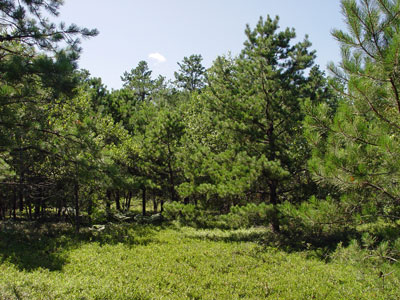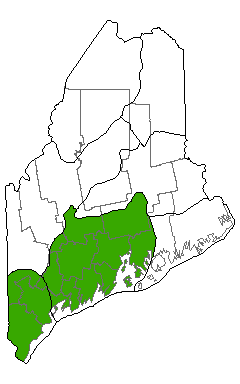DACF Home → Bureaus & Programs → Maine Natural Areas Program → Communities, Plants, and Animals → Natural Community Fact Sheets → Pitch Pine - Heath Barren
Printer Friendly Fact Sheet - 830 KB pdf (Get a free copy of Adobe Acrobat Reader)
Pitch Pine - Heath Barren
Scientific Name: Pitch Pine - Heath Barren; State Rank: S1

- Community Description
- Soil and Site Characteristics
- Diagnostics
- Similar Types
- Conservation, Wildlife and Management Considerations
- Distribution
- Characteristic Plants
- Associated Rare Plants
- Associated Rare Animals
- Examples on Conservation Lands You Can Visit
Community Description: This is an open canopy type in which pitch pine dominates the tree layer, with an understory of dwarf shrubs and herbs, and without an extensive tall shrub layer. Canopy cover is usually <50%, and openings with blueberry and lichens may occur within the barrens. Scrub oak may be present but at only low cover. Sites typically have an herb layer of lowbush blueberry and woodland sedge, with scattered bracken fern and forbs. Sharp-pointed ricegrass is characteristic, although it is rarely abundant. The lack of a shrub layer gives these barrens a park like appearance. Occasionally these may occur as almost closed canopy forests, but the pitch pines with the heath understory and little scrub oak retain the character of the type. Back to top.
Soil and Site Characteristics: Sites occur on well drained to very well drained sandy soils on outwash plains. Soils have little organic matter and are acidic. Topography is flat or very gently sloping. Sites generally have a history of periodic fire. Back to top.
Diagnostics: These are pitch pine dominated, partially forested areas which develop on sands or glacial outwash deposits, not on stabilized coastal dunes. Scrub oak is lacking or sparse. Back to top.
Similar Types: Pitch - Pine Dune Woodlands are also pitch pine dominated, but they occur on stabilized sand dunes along the coast and lack a well developed heath shrub layer. Pitch Pine - Scrub Oak Barrens are similar but have areas dominated by scrub oak or at least have scrub oak as a common component in the shrub layer. Back to top.
Conservation, Wildlife and Management Considerations: This community type is dependent upon periodic fires to eliminate competing tree species and prevent succession to an oak-pine forest. Because of habitat loss and fragmentation and a history of fire suppression, this forest type has become very rare. Most of the sites in the state have been degraded by permanent conversion to residential areas or sand and gravel mines.
Birds such as the eastern towhee, whip-poor-will, pine warbler, and prairie warbler may prefer this open habitat. Rare moths such as the pine pinion, oblique zale, and pine sphinx, which utilize pitch pine as a larval host plant, may be found in this community type. The pine-devil Moth, a historical species for Maine, probably also inhabited this community type, where its larvae fed on pitch pine. Back to top.
Distribution: Southern Maine (Eastern Broadleaf Forest Province), with a few sites in central Maine. Extends southward and southwestward from the state. Landscape Pattern: Large Patch. Back to top.


Characteristic Plants: These plants are frequently found in this community type. Those with an asterisk are often diagnostic of this community.
- Canopy
- Pitch pine*
- Sapling/shrub
- Scrub oak
- Sweetfern
- Dwarf Shrub
- Lowbush blueberry*
- Herb
- Sharp-pointed ricegrass
- Whorled loosestrife
- Woodland sedge*
- Edward's hairstreak
- Oblique zale
- Pine barrens itame
- Pine barrens zale
- Pine barrens zanclognatha
- Pine pinion
- Pine-devil moth
- Pink sallow
- Similar underwing
- Sleepy duskywing
- Southern pine sphinx
- The buckmoth
- Twilight moth
- Whip-poor-will
Examples on Conservation Lands You Can Visit
| Example | County |
|---|---|
| Brunswick Town Commons | Cumberland Co. |
| Jugtown Plains | Cumberland Co. |